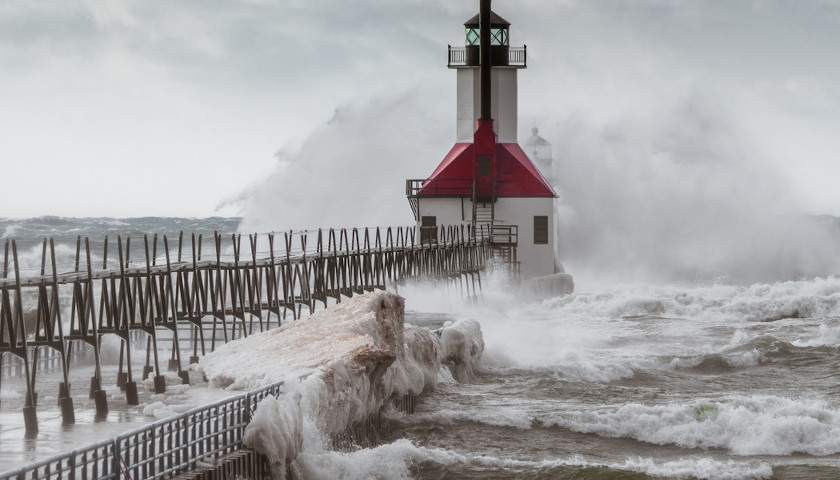After a record-breaking 2019, the US Army Corps of Engineers reported in their April summary that all five Great Lakes will again see a higher-than-average water levels. Lake Erie leads the way in 2020 with levels topping nine inches over last year.
Records show that the Great Lakes are experiencing the highest water levels since 1986. Water levels on the Great Lakes – which are connected by above- and below-ground waterways – are cyclical with periods of low and high water. Each period may last for several years depending on the amount of precipitation, runoff, and evaporation that occurs.
With the new highs come new challenges for shoreline structures that results in breakwater damage, beach erosion, watercraft, dock and pier damage, and in some cases, a flood threat to waterfront property.
Above average spring rainfall totals, including larger total volume of rainfall, prolonged rainfall events, and very intense individual rainfall events have occurred over the past several years also. These occurrences can cause erosion and flooding even when pre-existing water levels are normal.
According to the U.S Army of Corps Detroit Division:
Lake Michigan and Lake Huron’s monthly mean water level rose 3 inches from March to April to a level of 581.69 feet. Michigan‐Huron is also in its period of seasonal rise and is forecast to reach its peak monthly mean level in July. The levels are forecast to remain above LTA levels by 32 to 35 inches over the next 6 months.
Lake Michigan and Lake Huron are 11 inches higher than this time last year. That is a significant rise above last year.
Lake Erie continued its seasonal rise from March to April, rising about 4 inches to a level of 574.31 feet. In October, the forecast predicts Erie to be 10 inches below its record high level and 2 inches below last year’s level. Also, over the next 6 months Erie is forecast to be 24 to 28 inches above LTA levels.
Lake Superior began its seasonal rise from March to April by rising 2 inches to a level of 602.43 feet. Superior is in its period of seasonal rise and is expected to reach its peak monthly mean level in August. Over the next 6 months, Superior’s water levels are forecast to be 10 to 11 inches above LTA levels.
Lake St. Clair continued its seasonal rise and rose 3 inches from March to April to a level of 577.13 feet. This April level was also 33 inches above its monthly LTA level and 8 inches above last year’s level. Over the next 6 months, the lake is also projected to be 27 to 31 inches above its LTA levels.
Lake Ontario continued its seasonal rise from March to April and rose 6 inches to a level of 247.11 feet. This April level was 7 inches above the April 2019 level, 17 inches above the LTA level, and 13 inches below its record‐high level. Ontario is predicted to be 7 to 20 inches below last year’s levels and 9 to 16 inches above LTA levels. Ontario shoreline is vulnerable to along-shore and onshore winds blowing anywhere from east to north.
Over the next month, the U.S. Army Corps of Engineers forecasts water levels on Lake Superior to rise two inches. The forecast calls for Lakes Michigan and Huron to increase one inch in the next month, and remain at record high water levels. Lake Ontario is expected to rise three inches. Lake St. Clair is expected to fall one inch, and Lake Erie should fall two inches. These water level forecasts assume near-normal precipitation. If rainfall turns out to be heavier or lighter than normal, water level changes would be different.
President Trump implemented a $4.8 trillion budget proposal for the 2021 fiscal year that includes $320 million for the Great Lakes Restoration Initiative, a program the president previously tried to cut by 90%. Trump’s annual budgets require approval from Congress, which rejected the suggested cuts, and his newest proposal seeks $20 million more for the Great Lakes than legislation approved in the U.S. House.
Congress allocated $300 million for the GLRI every year since 2014. Trump’s budget proposal asks for $320 million, an increase of 6.7%.
According to data from the U.S. Army Corps of Engineers, all Great Lakes, except Michigan and Huron, set multiple monthly record levels in 2019. Lakes Erie, Superior, and the “sixth Great Lake,” Lake St. Clair, each set records five months in a row from May through September 2019.
– – –
Samantha Witwer is a reporter at The Ohio Star.





